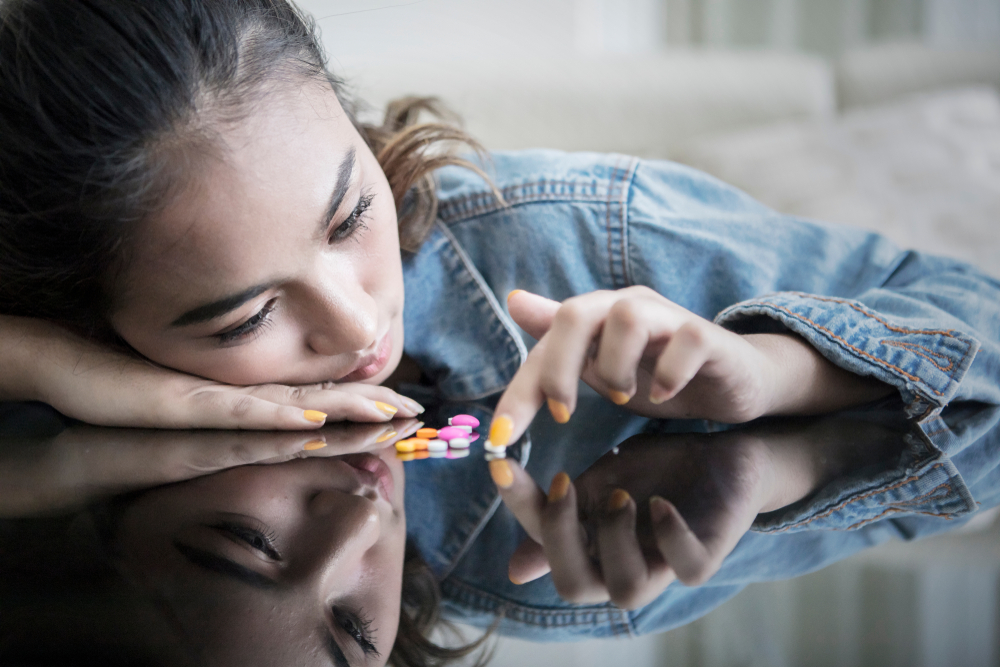Naltrexone for Alcohol Recovery: What It Is, How It Works, and How It’s Used in Rehab
Naltrexone is a prescription medication commonly used in alcohol or opioid recovery programs. But exactly what is naltrexone and how does naltrexone work? It’s an opioid antagonist which means that it blocks the effects of opioids, and it reduces alcohol cravings as well.
Naltrexone for alcohol recovery works by targeting brain receptors linked to pleasure and reward, making drinking less satisfying. Naltrexone for opioid withdrawal helps dampen symptoms of cravings and block euphoria if opioids are used. This helps you stay focused on your recovery and reduces your risk of relapse.

In rehab settings, naltrexone is often included in combination with counseling or behavioral therapy to improve your chances of long-term sobriety. It’s available as a daily oral tablet or a monthly injection, depending on your treatment plan.
Naltrexone may be one FDA-approved prescription drug considered in a medication-assisted treatment (MAT) program for alcohol or opioid withdrawal and rehab. A specialized healthcare provider can determine if naltrexone or other MAT medications could be helpful for your recovery.
What Is Naltrexone?
Naltrexone is an FDA-approved drug used to treat alcohol use disorder and opioid use disorder. This non addictive drug blocks the brain’s opioid receptors to reduce cravings and prevent the euphoric effects associated with alcohol and opioids.
Because it works in that way, naltrexone belongs to the drug class known as opioid antagonists. It helps you maintain abstinence by minimizing the reward or high associated with using opioids. It was originally developed to treat opioid addiction, but is now widely used to support alcohol use disorder recovery too.
Naltrexone medication does not cause physical dependence and does not lead to withdrawal symptoms when it’s discontinued. It is most effective when combined with behavioral therapy and medical supervision as part of a comprehensive treatment plan. Some common brand names include:
- Vivitrol (monthly injection)
- ReVia (oral tablets)
- Depade (oral tablets)
Naltrexone Uses
Many medications used in MAT are only available for treating one type of addiction like opioid addiction. Naltrexone is unique because it can be used for treating both alcohol addiction and opioid addiction. It can be used in inpatient rehab or outpatient treatment settings.
Naltrexone for Alcohol
How does naltrexone work for alcohol? In people with alcohol addiction, naltrexone blocks the brain’s opioid receptors, which are part of the system that reinforces the pleasurable response to drinking alcohol. As a result, drinking becomes less enjoyable.
This helps you control your cravings, avoid relapse, and stay focused on your recovery goals. Naltrexone is not a cure for addiction, but it is a powerful tool when used with counseling and behavioral therapy. A naltrexone and alcohol recovery program can improve your treatment outcomes.
The medication-assisted treatment (MAT) strategy is very beneficial if you have struggled with relapse or strong urges to drink, or if you have a history of relapse.
How Naltrexone Is Used in Inpatient and Outpatient Alcohol Rehab
Naltrexone is commonly used in inpatient and outpatient settings. Naltrexone in inpatient alcohol rehab is typically introduced after your detoxification is complete. It is administered under medical supervision and paired with structured therapy to promote sobriety and recovery. In this controlled setting, your healthcare providers can monitor side effects.
In an outpatient setting, naltrexone may be used orally every day or as a once-a-month injection known as Vivitrol. Naltrexone alcohol treatment can be included in any treatment setting, including intensive outpatient program. Supportive services such as telehealth check-ins, group therapy, or individual counseling are also used in your customized program.
Whether you are in an inpatient or outpatient program, naltrexone can play a key role in helping you stay committed to sobriety.
Key Considerations with Naltrexone for Alcohol Recovery
When you are beginning your alcohol recovery program with medications like naltrexone, there are several key facts to consider. First, naltrexone does not carry a risk of physical dependence. This makes it a safe option for long term use. Your doctor may recommend that you stop drinking for 7 to 10 days before starting the medication.
Another important factor is combining naltrexone treatment with behavioral health support, such as individual and group therapy. This approach addresses both the physical and psychological aspects of addiction at the same time. It significantly improves your outcomes and increases the likelihood of sustained recovery. To benefit from naltrexone, you need to be open to therapy too.
Naltrexone for Opioid Addiction Recovery
Naltrexone for opioid addiction is FDA approved to help prevent relapse if you are diagnosed with an opioid use disorder. Unlike other medications that manage withdrawal, your physician prescribes naltrexone after detox.
Naltrexone blocks the opioid receptors in your brain. This prevents the euphoric effects of opioids and reduces the motivation to use opioids because you are less likely to get high. Naltrexone for opioid relapse prevention is available as a daily oral tablet or a monthly injection. It’s not used to ease withdrawal symptoms, but it is effective in maintaining sobriety after detox.
Medications like clonidine or buprenorphine may be prescribed to reduce withdrawal symptoms during detox. You should not use naltrexone and opioids or other illicit drugs together since you may have a reduced tolerance and an increased risk of overdose.
Common Therapies Used with Naltrexone
As with any other MAT medication, naltrexone alone isn’t a solution for addiction. It helps with the physical aspects of addiction but long term recovery comes from addressing the mental aspects of addiction through therapy. While each program can take different approaches, these are some of the common therapies used with naltrexone.

Cognitive Behavioral Therapy (CBT): Cognitive behavioral therapy guides you to identify and change negative thought patterns and the behaviors that those thought patterns lead to. Your therapist helps you focus on building coping strategies and problem-solving skills for long term emotional and behavioral health.
Motivational Interviewing: This client centered approach helps you resolve ambivalence about making change. Using guided conversations, you are encouraged to explore internal motivation and commitment to healthy decisions.
Group Therapy: Group therapy offers peer support in a structured setting led by a therapist. Participants share experiences, give feedback, and build communication and social skills while working toward personal growth.
12 Step Facilitation: Using a 12 step program like Alcoholics Anonymous is an option in a clinical setting. It promotes acceptance, self reflection, and community connection. It can be used alongside other forms of evidence based therapy in your program.
How Naltrexone Works
How does Naltrexone work? This FDA approved medication blocks the mu-opioid receptors in the brain. These receptors are partially responsible for triggering pleasurable effects from alcohol and opioids.
When you consume these substances, you usually experience a surge in dopamine, a neurotransmitter linked to reward and reinforcement. Naltrexone disrupts this process and prevents the activation of opioid receptors, reducing dopamine release and making substance use less rewarding.
Naltrexone’s mechanism of action is central to its effectiveness. It does not cause euphoria or sedation, and it is not addictive. Instead, the role is to block the biochemical response that leads to cravings. This allows the medication to be a useful part of your long-term treatment plans.
Low Dose Naltrexone (LDN)
Low dose naltrexone (LDN) refers to the use of the medication in much smaller amounts than is normally used for addiction treatment. An LDN dosage is typically 0.5 mg to 4.5 mg per day. Although it is not FDA approved for the following purposes, LDN is used off-label to manage:
- Chronic pain
- Inflammation
- Fibromyalgia
- Multiple sclerosis
- Crohn’s disease
Researchers theorize that LDN works by briefly blocking opioid receptors, which may trigger your body to increase production of endorphins. This reduces the inflammatory response and can address symptoms of chronic pain and inflammatory conditions.
Unlike a standard dose used for addiction, low dose naltrexone is not intended to treat alcohol or opioid use disorder. It is being studied for the potential to manage the immune system and improve symptoms in certain chronic conditions.
What to Avoid When Taking Low Dose Naltrexone
It’s important to know what to avoid when taking low dose naltrexone or LDN. This can help prevent adverse effects and improve the drug’s effectiveness. Avoid alcohol, opioids, or other narcotic pain killers. Since naltrexone blocks opioid receptors, it can interfere with pain relief or trigger withdrawal symptoms.
Using alcohol can increase the strain on your liver. If you’re using LDN for inflammation or an autoimmune condition, avoid immunosuppressants unless your doctor knows you take LDN and specifically directs you to take them. The naltrexone interaction when combining LDN with an immunosuppressive drug can reduce the intended benefits.
Naltrexone Interactions
Naltrexone can interact with several types of medications and should not be used in combination with prescription painkillers, opioids, or other illicit substances. Naltrexone with opioids may trigger a rapid yet extreme withdrawal. The reaction is intense and potentially dangerous, which is why a complete detox is required before starting treatment.
You should also be cautious when using naltrexone alongside other substances that affect your liver. These might include:
- Acetaminophen (Tylenol)
- Alcohol
- Certain antibiotics
- Nonsteroidal anti-inflammatory drugs (NSAIDs)
- Other medications known to be toxic to your liver
Liver function tests may be recommended before and during treatment to monitor your liver function. Understanding these interactions is critical to safe use and your successful recovery.
Naltrexone Side Effects
Naltrexone is usually well tolerated but some side effects can occur. Naltrexone side effects depend on the dose and how the drug is administered. The following are some of the potential side effects to be aware of:
- Nausea
- Dizziness
- Headache
- Fatigue
- Elevated liver enzymes (this is uncommon but liver monitoring is recommended)
- Injection-site reactions (specific to the Vivitrol form of naltrexone)
Low dose naltrexone side effects are usually mild, but you might still experience a headache or sleep disturbances. Always report any unusual symptoms to your healthcare provider.
FAQs About Naltrexone
Naltrexone could cause fatigue, especially when you’re beginning treatment. However, this side effect is usually mild and temporary. Tell your healthcare provider if tiredness persists or interferes with your daily activities.
Naltrexone could help you lose weight by reducing food cravings and affecting the brain reward pathway. It is often combined with bupropion in a prescription drug called Contrave for obesity management.
How long it takes for naltrexone to work depends on several factors. It usually starts working within 1 to 2 hours after you take the oral dose. However, your craving reduction may take a few days to be noticeable.
Side effects from low dose naltrexone are usually mild and temporary. As your body adjusts to the medication, the side effects can resolve within a few days to two weeks. If you experience persistent symptoms, talk with your healthcare provider.
No, naltrexone isn’t a controlled substance though some other MAT medications are. The US classifies controlled substances based on their risk for abuse, and because naltrexone doesn’t cause dependence or a high, it’s not a controlled substance.
Naltrexone is not a weight loss drug when used alone. However, it can reduce cravings that contribute to overeating. When it’s combined with bupropion, it is an FDA-approved drug (Contrave) for weight management.
Considering Naltrexone for Alcohol Addiction Recovery
For many, naltrexone is a vital part of the path to recover from alcohol addiction or opioid addiction. If you believe this can be helpful for you too, Treatment Centers Directory can show you facilities in your area that use naltrexone as part of their medication assisted treatment for addiction.
Articles About Alcohol & Treatment

Women’s Rehab
Women’s Drug Rehab: Overcoming Addiction in a Supportive Environment According to the 2019 National Survey on Drug Use and Health

Veterans Drug Rehab
Addiction Treatment Programs for Veterans U.S. military veterans from all branches of service–Army, Navy, Air Force, Coast Guard, Marine Corps,

Teen Rehab
Addiction Treatment Programs for Teens More teenagers are using illicit drugs than ever before. According to the National Center for